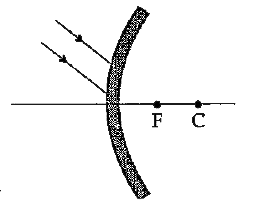To construct a ray diagram we use two rays of light which are so chosen that it is easy to determine their directions after reflection from the mirror. Choose these two ras and state the path of these rays after reflection from a concave mirror . Use these two rays to find the nature and position of the image of an object plced at a distance of 15 cm from a concave mirror of focal length 10 cm.
To solve the problem, we will follow these steps:
Step 1: Identify the given values
- Object distance (u) = -15 cm (negative because the object is on the same side as the incoming light)
- Focal length (f) = -10 cm (negative for concave mirror)
Step 2: Use the mirror formula
The mirror formula is given by:
1f=1v+1u
Substituting the values of f and u:
1−10=1v+1−15
Step 3: Rearrange the equation
Rearranging the equation to find v:
1v=1−10+115
Step 4: Find a common denominator
The common denominator for -10 and 15 is 30. Now we rewrite the fractions:
1v=−330+230=−130
Step 5: Solve for v
Taking the reciprocal gives:
v=−30 cm
This indicates that the image is formed 30 cm in front of the mirror (on the same side as the object).
Step 6: Determine the nature of the image
Since v is negative, the image is real and inverted.
Step 7: Draw the ray diagram
1. Draw a concave mirror and label the principal axis, pole (P), focus (F), and center of curvature (C).
2. Mark the object (AB) at 15 cm from the mirror.
3. Draw the first ray parallel to the principal axis from the top of the object (A). After reflection, this ray will pass through the focus (F).
4. Draw the second ray passing through the pole (P) of the mirror. This ray reflects back at the same angle.
5. The intersection of the two reflected rays gives the position of the image (A'B').
Step 8: Conclusion
- The image is real, inverted, and located 30 cm from the mirror.
---
- Object distance (u) = -15 cm (negative because the object is on the same side as the incoming light)
- Focal length (f) = -10 cm (negative for concave mirror)
The mirror formula is given by:
1f=1v+1u
Substituting the values of f and u:
1−10=1v+1−15
Rearranging the equation to find v:
1v=1−10+115
The common denominator for -10 and 15 is 30. Now we rewrite the fractions:
1v=−330+230=−130
Taking the reciprocal gives:
v=−30 cm
This indicates that the image is formed 30 cm in front of the mirror (on the same side as the object).
Since v is negative, the image is real and inverted.
1. Draw a concave mirror and label the principal axis, pole (P), focus (F), and center of curvature (C).
2. Mark the object (AB) at 15 cm from the mirror.
3. Draw the first ray parallel to the principal axis from the top of the object (A). After reflection, this ray will pass through the focus (F).
4. Draw the second ray passing through the pole (P) of the mirror. This ray reflects back at the same angle.
5. The intersection of the two reflected rays gives the position of the image (A'B').
- The image is real, inverted, and located 30 cm from the mirror.
Similar Questions
To construct a ray diagram, we use two rays which are so chosen that it is easy to know their directions after reflection from the mirror. List two such rays and state the path of these rays after reflection in case of concave mirrors. Use these two rays and draw ray diagram to locate the image of an object placed between pole and focus of a concave mirror.
View SolutionA ray of light passing through the focus, after reflection from a concave mirror travels ……….
View Solution
Knowledge Check
A ray of light after reflection from a mirror is known as
Areflected rayBnormalCincident rayDrefracted ray
Assertion: A convex mirror always make a virtual image.
Reason: The ray always diverge after reflection from the convex mirror.
View SolutionState the direction of incident ray which after reflection from a spherical mirror retraces its path. Give a reason to your answer.
View SolutionComplete the ray diagram as shown to show the formation of image for parallel rays incident on a convex mirror. State the position, nature and size of the image formed.

View SolutionTwo plane mirrors are inclined to each other at an angle θ. A ray of light is reflected at one
mirror and then at the other. Find the total deviation of the ray.
View SolutionIn Figure A, draw the reflected ray from the mirror and refracted ray into the air.

View SolutionDraw the following diagram, in which a ray of light is incident on a concave/convex mirror, on your answer sheet . Show the path of this ray, after reflection, in each case.

View SolutionAn object is placed between a plane mirror and a concave mirror of focal length 15 cm as shown in Figure . Find the position of the images after two reflections.

View Solution
